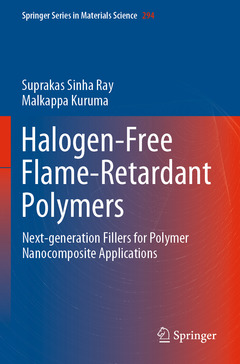Description
Halogen-Free Flame-Retardant Polymers, 1st ed. 2020
Next-generation Fillers for Polymer Nanocomposite Applications
Springer Series in Materials Science Series, Vol. 294
Authors: Sinha Ray Suprakas, Kuruma Malkappa
Language: English
Subject for Halogen-Free Flame-Retardant Polymers:
Approximative price 105.49 €
In Print (Delivery period: 15 days).
Add to cartPublication date: 02-2021
Support: Print on demand
Approximative price 105.49 €
In Print (Delivery period: 15 days).
Add to cartPublication date: 02-2020
113 p. · 15.5x23.5 cm · Hardback
Description
/li>Contents
/li>Biography
/li>Comment
/li>
This book presents an overview of recent academic and industrial research efforts concerning halogen-free flame-retardant (FR) polymers and their nanocomposites. It summarizes the synthesis methods for various types of halogen-free FR polymers and their nanocomposites, and critically reviews their flame-retardant behavior, toxic-gas evolution during combustion, and inhibition methods.
In turn, the book discusses the importance of metal oxide nanoparticles, nanoclay, and graphene in flame inhibition and addresses the FR properties of various FR compounds containing polymers, their FR mechanisms, and fire toxicant releasing and inhibition methods in detail. It systematically covers the synergetic effects between different FR compounds, and explains the significance of thermal stability and melt dripping for polymers? FR properties.
The fundamental concepts described here are essential to understanding the FR behaviors of various polymers and their nanocomposites, and to developing efficient, environmentally friendly FR polymers and nanocomposites for a wide range of applications. This book is ideally suited for researchers in the fields of polymer science and engineering, and for graduate students in chemistry and materials science.
Introduction.- Polymer combustion and flame retardancy.- Fire retardant polymers.- Flame-retardancy testing.- Importance of polyols in flame-retardant PUs.- Types of halogen-free fire-retardants (FRs).- UV-curable FRs.- Relationship between the melting dripping characteristics of polymer films.- Importance of char formation and morphology in FR activity.- Polymer nanocomposites for FR applications.- Conclusions and future scope.- References.
Provides a comprehensive review of recent research efforts concerning halogen-free flame-retardant polymers and their nanocomposites
Addresses the properties and mechanisms of various polymer-containing fire retardant compounds
Discusses different methods for fire toxicant release and inhibition
Aids researchers in developing efficient, environmentally friendly fire retardant polymers and nanocomposites




